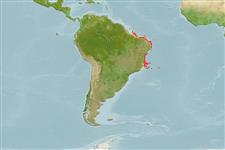>
Blenniiformes (Blennies) >
Blenniidae (Combtooth blennies) > Salariinae
Etymology: Hypleurochilus: Greek, hypo = under + Greek, pleura = in the side of + Greek, cheilos = lip; brasil: Named after the vivid red spots, similar to incandescent pieces of a brazing; Brazil’s country name (Brasil in Portuguese), where the species is endemic, originally has a similar derivation (name given in recognition of the reddish colour of the wood of a large Brazilian native tree - Caesalpinia echinata, 'Pau-Brasil' in Portuguese); noun in apposition..
Environment: milieu / climate zone / depth range / distribution range
Ekologi
laut berasosiasi dengan karang; kisaran kedalaman 3 - 15 m (Ref. 94079). Tropical
Western Atlantic: Brazil (Trindade Island and Martin Vaz).
Size / Weight / umur
Maturity: Lm ? range ? - ? cm
Max length : 3.1 cm SL jantan/; (Ref. 94079); 2.7 cm SL (female)
deskripsi pendek
Morfologi | Morfometrik
Duri punggung (Keseluruhan (total)): 12; duri punggung lunak (Keseluruhan (total)): 13-14; Duri dubur 2; Sirip dubur lunak: 15 - 16; vertebrata, bertulang belakang: 36. This species is distinguished from its congeners by the following set of characters: pelvic-fin rays I, 3, dorsal fin usually XII,13, anal fin II,15-16 (usually 16), no blackened stripes, nape green or white and presence of numerous tiny red spots along body, diminishing in size posteriorly (Ref. 94079).
Found either solitary or in small groups of up to 10 individuals; in small holes or associated with sea-urchins and sponges on the rocky reefs (Ref. 94079). Oviparous. Eggs are demersal and adhesive (Ref. 205), and are attached to the substrate via a filamentous, adhesive pad or pedestal (Ref. 94114). Larvae are planktonic, often found in shallow, coastal waters (Ref. 94114).
Pinheiro, H.T., J.L. Gasparini and C.A. Rangel, 2013. A new species of the genus Hypleurochilus (Teleostei: Blenniidae) from Trindade Island and Martin Vaz Archipelago, Brazil. Zootaxa 3709(1):95-100. (Ref. 94079)
Status IUCN Red List (Ref. 130435)
ancaman kepada manusia
Harmless
penggunaan manusia
informasi lanjut
Umur / SaizPertumbuhanpanjang-beratpanjang-panjangukuran frekuensiMorfometrikMorfologiLarvaDinamika larvapemulihanKelimpahanBRUVS
AcuanBudidaya airprofil budidaya airStrainGenetikaElectrophoresesDiturunkanPenyakit-penyakitPengolahanNutrientsMass conversion
mitraGambarStamps, Coins Misc.Suara-suaraCiguateraKecepatanTipe renangArea insangOtolithsOtakPenglihatan / visi
Alat, peralatan
laporan khas
muat turun XML
Sumber internet
Estimates based on models
Preferred temperature (Ref.
123201): 25.8 - 27.6, mean 27.4 °C (based on 98 cells).
Phylogenetic diversity index (Ref.
82804): PD
50 = 0.5005 [Uniqueness, from 0.5 = low to 2.0 = high].
Bayesian length-weight: a=0.00741 (0.00335 - 0.01640), b=3.02 (2.83 - 3.21), in cm total length, based on LWR estimates for this (Sub)family-body shape (Ref.
93245).
Trophic level (Ref.
69278): 3.1 ±0.3 se; based on size and trophs of closest relatives
Daya lenting (Ref.
120179): Tinggi, Waktu penggandaan populasi minimum kurang dari 15 bulan (Preliminary K or Fecundity.).
Fishing Vulnerability (Ref.
59153): Low vulnerability (10 of 100).
